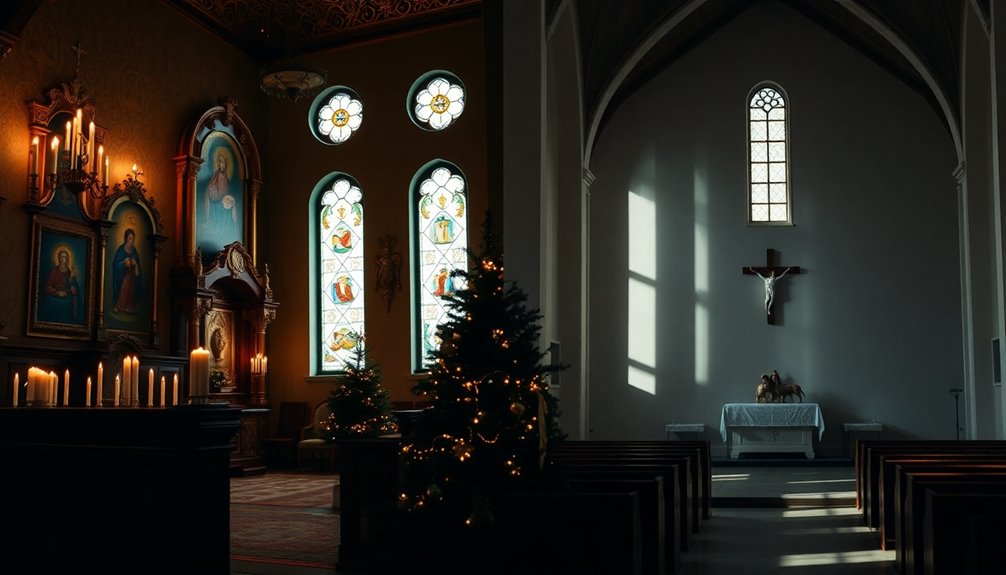Orthodox Christmas is different from Catholic Christmas mainly because of calendar differences, worship practices, and cultural traditions. You'll notice that Orthodox Christians celebrate on January 6-7, using the Julian calendar, while Catholics celebrate on December 25, following the Gregorian calendar. Additionally, Orthodox services tend to be longer and include ancient hymns, while Catholics have distinct masses. You'll also find unique customs, like Orthodox meals with twelve meatless dishes and vibrant caroling traditions. These differences highlight rich cultural and spiritual traditions. If you're curious about more specifics, there's plenty more to explore on this fascinating topic.
Key Takeaways
- Orthodox Christmas is celebrated on January 6-7 due to the Julian calendar, while Catholics celebrate on December 25 using the Gregorian calendar.
- Orthodox services last nearly three hours, combining multiple liturgical elements, whereas Catholic Christmas includes three separate masses: Vigil, Midnight, and Day Mass.
- Traditional Orthodox Christmas meals feature 12 meatless dishes symbolizing the apostles, contrasting with Catholic meals that may include fish.
- Unique regional practices, such as puppet theater in Ukraine and ceremonial traditions in the Balkans, enrich Orthodox Christmas celebrations.
- Caroling in Orthodox communities involves communal visits and blessings, enhancing community spirit, while calendar differences challenge Orthodox-Catholic relations.
Calendar Differences
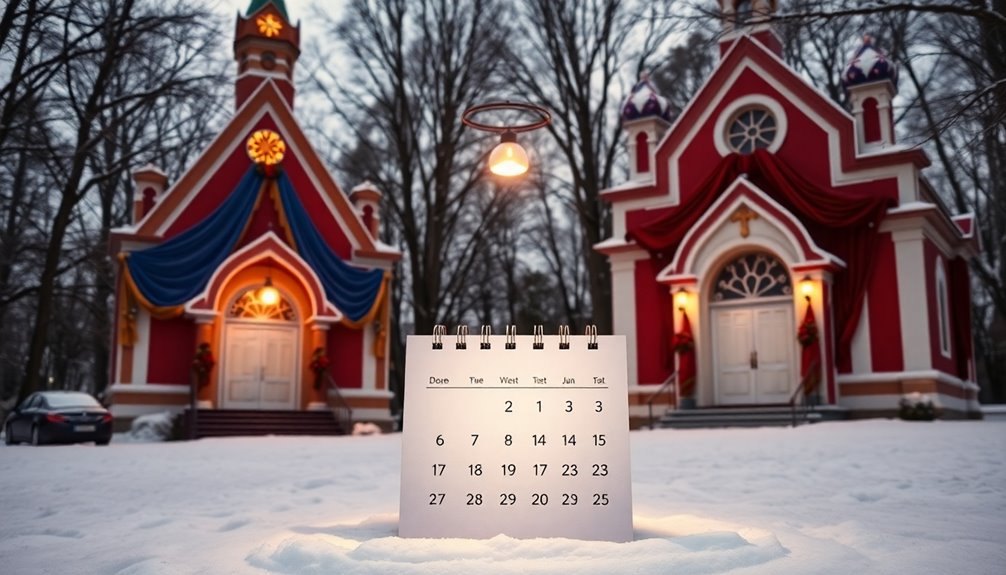
When it comes to Christmas celebrations, one key difference lies in the calendars used by Orthodox and Catholic Christians.
Orthodox Christians celebrate Christmas on January 6-7, adhering to the Julian calendar, which is currently 13 days behind the Gregorian calendar that Catholics and most Western Christians follow.
The Julian calendar, established by Julius Caesar, has been replaced by the Gregorian calendar introduced by Pope Gregory XIII to fix inaccuracies.
This calendar difference creates a two-week gap in Christmas celebrations, influencing communal customs and traditions. For many, this period becomes an opportunity to engage in unique cultural practices that vary significantly from the typical Western festivities. One such example is the yellow chrysanthemum symbolism in China, where this flower represents longevity and rejuvenation, often adorning homes during the festive season as a reminder of new beginnings. As families come together to celebrate, they also reflect on the rich tapestry of their heritage, blending traditional elements with the spirit of the holiday.
Notably, about 80% of Orthodox parishes in France now celebrate Christmas on December 25, reflecting a trend among some Orthodox communities to adopt the Gregorian calendar, but the core differences remain significant.
Cultural Traditions
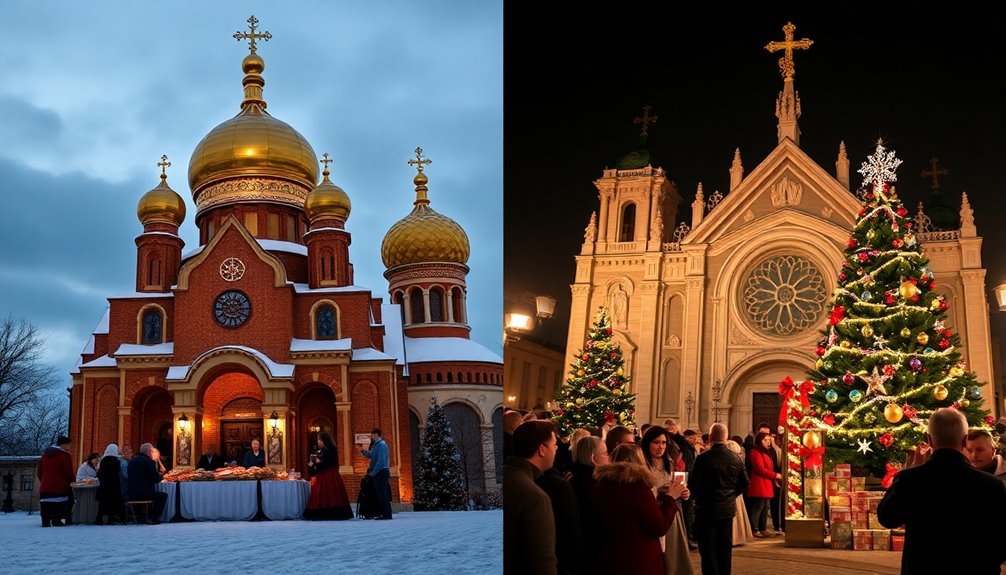
When it comes to cultural traditions, you'll find distinct practices in Orthodox and Catholic Christmas celebrations.
From the traditional greetings exchanged to the specific customs of Christmas Eve meals, each faith offers unique regional flavors that enrich their festivities.
You might also notice how gift-giving varies considerably between the two, adding another layer to the celebration.
Traditional Greetings and Responses
How do Orthodox Christians celebrate the joy of Christ's birth through traditional greetings?
During Orthodox Christmas, you'll hear the uplifting phrase "Christ is born!" exchanged among community members, met with the joyful response "Glory to him!" This simple yet powerful greeting captures the essence of the holiday, fostering a spirit of unity and shared faith.
The exchange is a significant part of the festivities, emphasizing the joy of Christ's birth and creating bonds among believers. While the exact form of these traditional greetings may vary by region, they're universally recognized within Orthodox Christian communities worldwide.
You'll find that these greetings are often shared during communal gatherings and church services, enhancing the festive atmosphere of the celebration.
Christmas Eve Meal Customs
As the joyful greetings of Orthodox Christmas fill the air, families come together to share a special Christmas Eve meal rich in tradition.
In Orthodox traditions, this meal features 12 meatless dishes, symbolizing the apostles, and is served on January 6. A staple is kutia, a sweet porridge made from wheat, honey, and poppy seeds, representing prosperity.
Unlike Catholic Christmas Eve, which often includes fish and vegetable dishes, Orthodox meals are alcohol-free, reflecting a spirit of fasting. Both traditions celebrate in a communal setting, fostering unity.
However, Orthodox customs include the Paramony service, where readings from the Old Scriptures related to the Nativity precede the meal, deepening the spiritual significance of the evening.
Unique Regional Practices
Christmas traditions vary widely within Orthodox communities, showcasing unique regional practices that enrich the celebration.
Each culture adds its own flavor to the festivities, making Orthodox Christmas distinct and memorable.
Here are some fascinating practices you might encounter:
- Traditional Christmas Eve meal: In many Orthodox homes, you'll find 12 vegetarian dishes representing the apostles.
- The vertep: In Ukraine, puppet theater performances based on the nativity run from January 6 to 19.
- Paramony service: On December 24, communal gatherings feature Old scriptures readings relevant to Christ's birth.
- Epiphany customs: In Bulgaria and Greece, priests throw crucifixes into water, symbolizing Jesus's baptism.
These unique regional practices highlight the rich tapestry of Orthodox Christmas celebrations.
Regional Practices
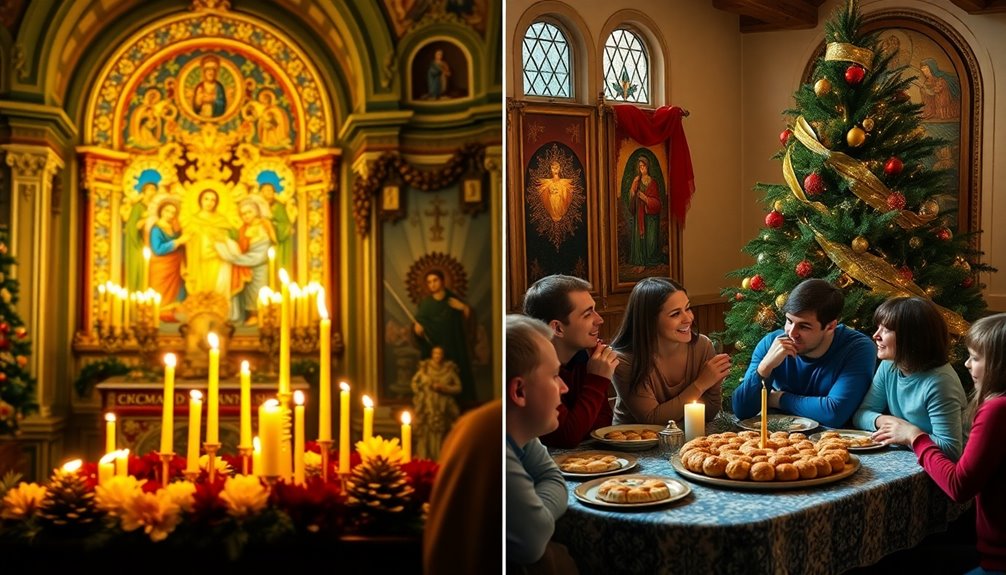
While many people think of Christmas as a single day, regional practices among Orthodox Christians reveal a rich tapestry of traditions shaped by local cultures and calendars.
Unlike Catholic Christmas celebrations on December 25, Orthodox churches celebrate Christmas on January 6-7 due to their use of the Julian calendar.
In Bulgaria and Greece, January 19 marks Epiphany, where priests throw crucifixes into water to symbolize Jesus's baptism.
Eastern European customs also include unique New Year traditions around January 13-14.
In Ukraine, vertep puppet theatre performances from January 6 to 19 showcase local culture.
Additionally, the ceremonial burning of the badnjak on Christmas Eve in the Western Balkans highlights the diverse ways Orthodox and Catholic communities observe the holiday.
Unique Celebrations
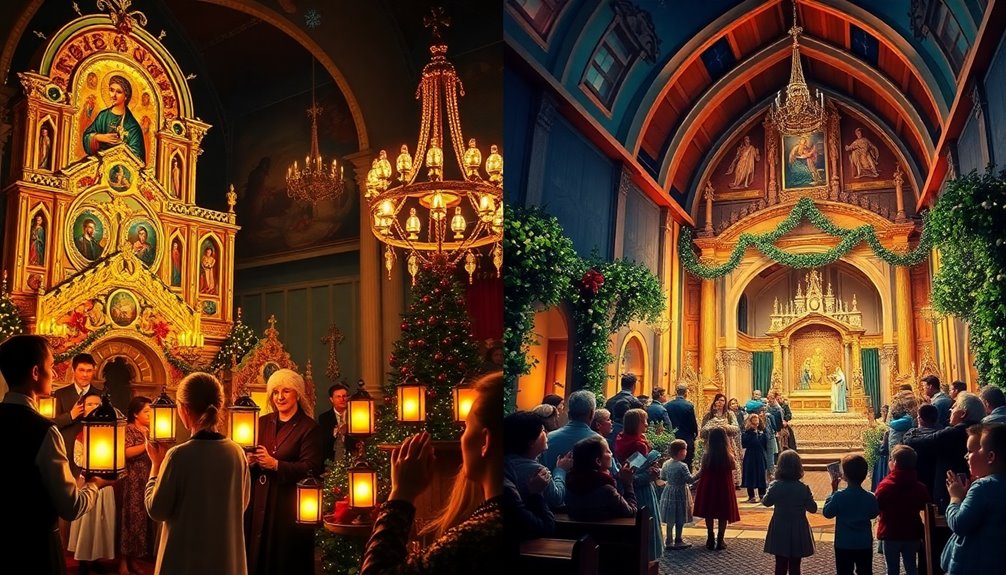
Building on the rich regional practices of Orthodox Christians, unique celebrations further distinguish their holiday observances.
These festivities often highlight traditions that aren't found in Catholic customs. For instance, you might experience:
- A Christmas Eve meal consisting of 12 meatless dishes, symbolizing the apostles.
- Fasting until the first star appears, marking the anticipation of Christ's birth.
- The vibrant "vertep" puppet theater performances in Ukraine, blending nativity stories with pre-Christian traditions.
- Joyful caroling, where groups visit homes to share the Christmas message, creating a communal spirit.
These unique celebrations showcase the depth of Orthodox traditions, making each holiday experience truly special and meaningful.
Historical Context

Understanding the historical context behind the celebration of Christmas reveals significant differences between Orthodox and Catholic traditions.
The split largely comes from the calendars used: the Orthodox churches often follow the Julian calendar, while Catholics adhere to the Gregorian calendar introduced in 1582. This discrepancy means that Orthodox Christmas is celebrated on January 6-7, approximately 13 days later than the December 25 date recognized by most Catholic Christians.
The Council of Ephesus in 431 AD established December 25 as Christmas, which many accepted, but the continuation of the Julian calendar by some Orthodox churches led to the current divide.
Notably, around 80% of Orthodox parishes in France now celebrate Christmas on December 25, showcasing the diverse adherence to these calendar systems.
Meaning of the Holiday
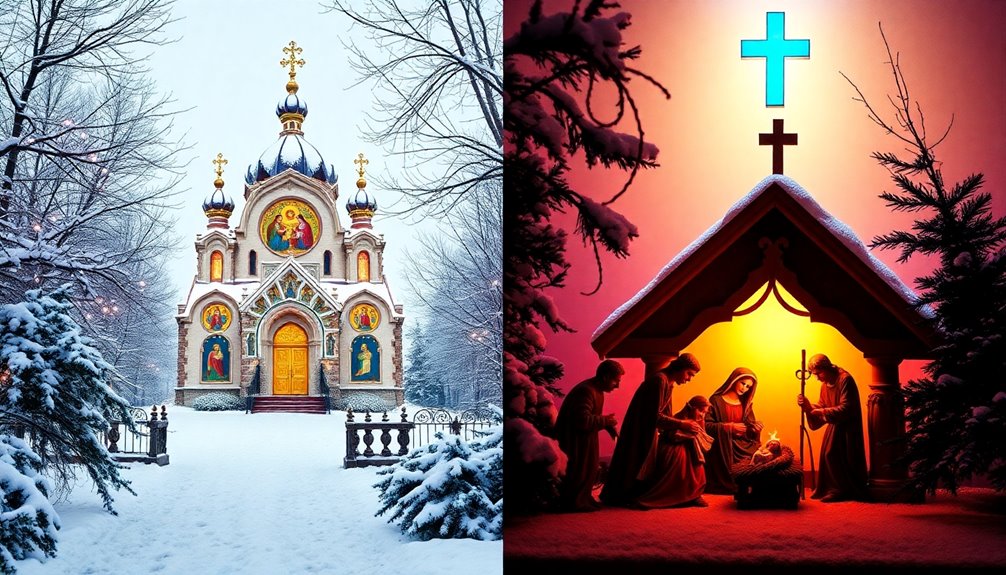
The meaning of Christmas varies considerably between Orthodox and Catholic traditions, reflecting their unique theological perspectives and practices.
For Orthodox Christians, the holiday emphasizes the spiritual significance of Christ's Nativity, while Catholics focus on family gatherings.
Here are some key differences in meaning:
- Preparation: Orthodox Christmas involves a longer fasting period starting November 15, whereas Catholics follow the Advent season.
- Liturgical Services: Orthodox Christians attend a service centered on Old Scriptures readings, while Catholics typically hold a structured mass.
- Christmas Eve Meals: The Orthodox tradition includes 12 lean dishes symbolizing the apostles, while Catholic meals often feature fish.
- Community Focus: The Orthodox Church emphasizes communal worship, highlighting the holiday's observance in a collective setting.
Worship Practices
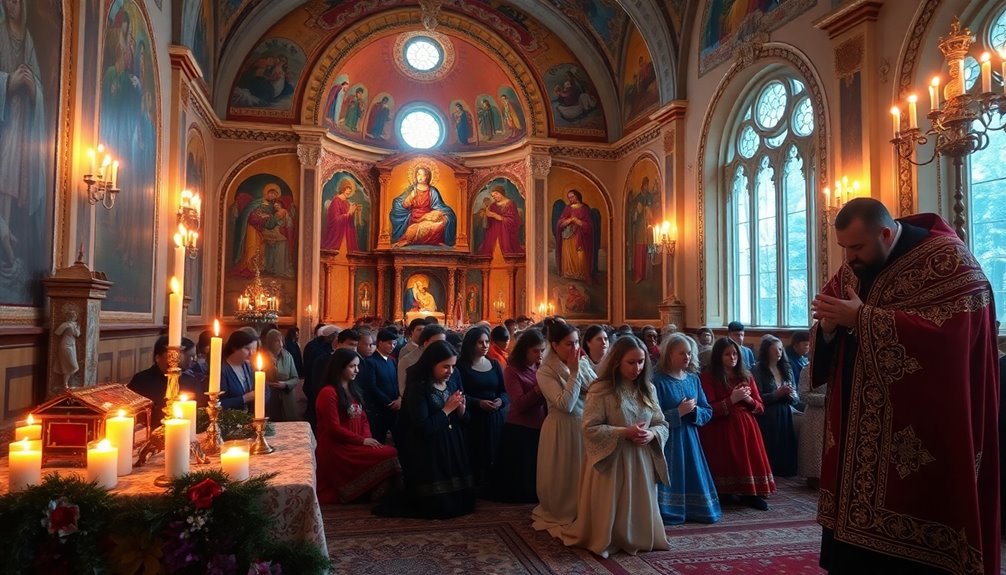
When you compare Orthodox and Catholic Christmas worship practices, you'll notice distinct liturgical structures.
Orthodox services blend multiple elements into one lengthy celebration, while Catholics hold three separate masses to mark the occasion.
Each tradition also highlights unique service elements that reflect their understanding of the Nativity's significance.
Liturgical Structure Variations
While both Orthodox and Catholic Christmas celebrations center on the Nativity, their liturgical structures differ considerably.
In the Orthodox tradition, you'll find an extended service that combines the Great Covenant, Matins, and Liturgy into one. This often leads to a service lasting nearly three hours on Christmas Eve, encouraging higher attendance.
In contrast, Catholic Christmas involves three distinct masses:
- Vigil Mass on Christmas Eve
- Mass at Midnight
- Mass during the Day
Orthodox services emphasize a rich tapestry of tradition, utilizing ancient hymns and extensive Old scripture readings.
The unique liturgical calendar for Orthodox Christmas highlights the spiritual focus on the Nativity, setting it apart from Catholic practices.
Unique Service Elements
Unlike Catholic services, Orthodox Christmas worship features a unique blend of elements that create a deeply immersive experience.
Orthodox Christmas services combine the Great Covenant, Matins, and Divine Liturgy into a single, thorough Christmas liturgy celebrated on December 24. This service lasts nearly three hours and often attracts higher attendance than regular Sunday gatherings.
On this day, the Paramony service includes Old Scriptures readings that highlight the Nativity's scriptural foundation. Additionally, the Orthodox Church observes a longer preparation period, beginning with a fast on November 15, contrasting with the Catholic Advent season.
While Catholics celebrate three distinct masses, Orthodox Christians focus on this unified worship experience, making the celebration truly special and significant.
Festive Table
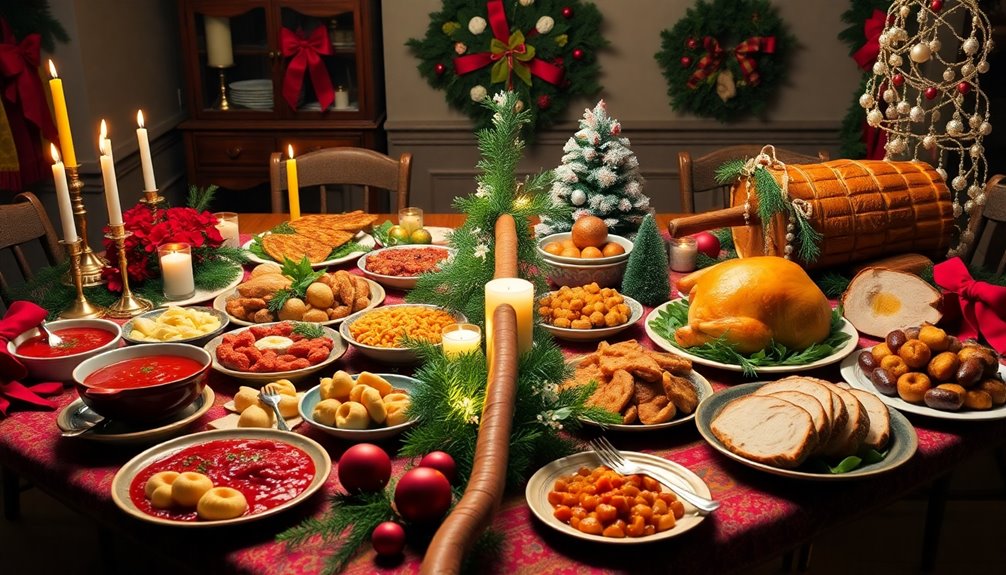
As Orthodox Christians gather around the festive table on Christmas Eve, they share a meal that reflects deep spiritual significance and communal bonds. This traditional Christmas Eve meal features 12 lean dishes, symbolizing the apostles, and is typically meat and alcohol-free.
The first dish often served is kutia, a porridge-like blend of wheat, honey, and poppy seeds, marking the beginning of the celebration.
Key elements of the festive table include:
- A variety of lean dishes that highlight regional traditions
- Kutia, which holds special importance in Orthodox Christmas celebrations
- Emphasis on communal sharing and togetherness
- A departure from fasting with meat meals on Christmas Day
These customs create a unique and cherished experience for Orthodox families.
Caroling Customs

When it comes to Christmas caroling, Orthodox and Catholic traditions take different approaches.
You'll find Orthodox carolers spreading joy through communal visits and songs that celebrate both the Nativity and ancient customs.
In contrast, Catholic caroling tends to focus more on intimate family gatherings, creating a cozy holiday atmosphere.
Orthodox Caroling Traditions
In many Orthodox communities, caroling traditions bring joy and a sense of togetherness during the Christmas season. Groups of carolers, often children, visit homes to share the Christmas message, strengthening community bonding.
You might experience carolers singing traditional hymns while re-enacting the Nativity story, especially in places like Ukraine where puppet theaters called vertep add a unique touch.
Here are some highlights of Orthodox caroling traditions:
- Carolers bless homes by singing joyful songs about the Nativity.
- Treats or small gifts are often exchanged, enhancing community spirit.
- The performances encourage participation from the wider community.
- Songs reflect local cultural traditions intertwined with religious significance.
These customs create a festive atmosphere that truly embodies the essence of Christmas.
Catholic Caroling Practices
While many cherish the warmth of family gatherings during the Christmas season, Catholic caroling practices often focus on intimate settings rather than public displays.
You'll find that catholic caroling typically unfolds within family circles, where loved ones gather to sing traditional hymns that celebrate the birth of Christ.
Unlike more structured performances, this caroling is spontaneous and informal, creating a cozy atmosphere.
In some cultures, these caroling sessions blend seamlessly into the larger Christmas Eve celebrations, often accompanied by rituals like attending midnight mass.
The spirit of giving shines through, as carolers sometimes collect donations for charity or share treats with neighbors, fostering a sense of community and joy during this special time of year.
Ecumenical Relations
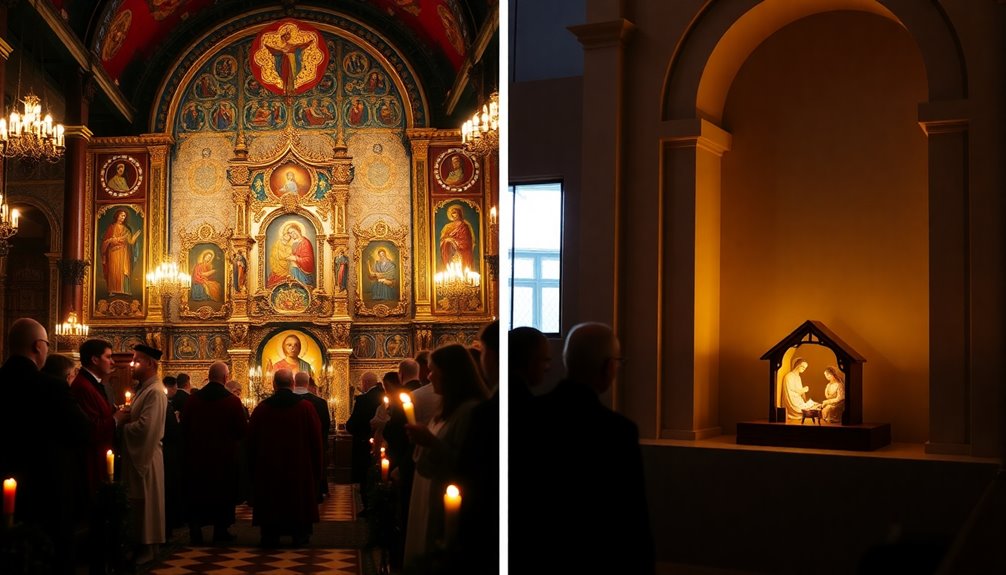
Ecumenical relations between Orthodox and Catholic churches have made strides, yet significant challenges persist, especially concerning calendar discrepancies.
Pope Francis aims for a unified Easter date by 2025, but the differences in calendar practices complicate this goal. Here are some key points to take into account:
- The Russian Orthodox Church follows the Julian calendar.
- Many other Orthodox churches have adopted the Gregorian calendar.
- Most Orthodox believers still celebrate Christ's birth on December 25.
- Recent Catholic actions have raised concerns among Orthodox Christians.
Despite these challenges, ongoing dialogue highlights shared beliefs while tackling deeper theological disagreements.
Bridging these gaps requires mutual respect and understanding, fostering unity between the Catholic Church and the Orthodox Church.
Frequently Asked Questions
Why Is Orthodox Christmas Different?
Orthodox Christmas is different mainly due to its celebration on January 6-7, stemming from the Julian calendar.
You'll notice that Orthodox Christians often observe a pre-Christmas fast starting November 15, which is longer than Advent.
On Christmas Eve, they typically enjoy a meat-free meal featuring 12 dishes, with Kutia being significant.
Additionally, the liturgy lasts almost three hours, attracting more attendees than regular services, making the experience unique and deeply spiritual.
What Is the Key Difference Between Catholic and Orthodox?
Isn't it ironic how two branches of Christianity celebrate the same event on different days?
You'll find that the key difference between Catholic and Orthodox traditions lies in their calendars. While Catholics joyfully unwrap gifts on December 25, Orthodox Christians patiently wait until January 6-7.
This divergence extends to their preparation rituals, meals, and liturgical practices, making each celebration uniquely rich and meaningful in its own right.
Who knew a date could create such varied traditions?
Why Is Christmas on Jan 6 for Orthodox?
Christmas falls on January 6-7 for Orthodox Christians because they follow the Julian calendar, which is 13 days behind the Gregorian calendar.
Established in 46 BC, the Julian calendar miscalculates the solar year, leading to the different celebration dates.
While many Orthodox churches recognize December 25 as Christ's birth, those using the Julian calendar maintain their tradition of celebrating on January 6-7, emphasizing their historical and cultural significance.
What Is the Difference Between Epiphany and Orthodox Christmas?
When you compare Epiphany and Orthodox Christmas, you'll notice key differences.
Orthodox Christmas, celebrated on January 6-7, focuses on the Nativity of Christ, while Epiphany, observed on January 19 in Orthodox traditions, emphasizes Jesus' baptism.
In Western Christianity, Epiphany falls on January 6, marking the Magi's visit.
Fundamentally, you see Orthodox Christmas as the birth of Christ, while Epiphany reveals His identity as the Son of God through baptism.
Conclusion
In the grand tapestry of faith, Orthodox and Catholic Christmases weave their own vibrant threads. While the calendar may differ and traditions vary, both celebrations share a core of love and hope. So, whether you're savoring a festive feast or joining in joyful carols, you're part of a rich heritage that transcends boundaries. Embrace the unique customs, for each one adds a special touch to this beautiful season of togetherness and light.
